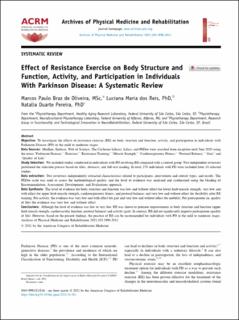Effect of Resistance Exercise on Body Structure and Function, Activity, and Participation in Individuals With Parkinson Disease: A Systematic Review
Original version
Braz de Oliveira, M. P., Maria dos Reis, L., & Pereira, N. D. (2021). Effect of Resistance Exercise on Body Structure and Function, Activity, and Participation in Individuals With Parkinson Disease: A Systematic Review. Arch Phys Med Rehabil. https://doi.org/10.1016/j.apmr.2021.01.081Abstract
Objective
To investigate the effects of resistance exercise (RE) on body structure and function, activity, and participation in individuals with Parkinson Disease (PD) in the mild to moderate stages.
Data Sources
Medline, Embase, Web of Science, The Cochrane Library, Lilacs, and PEDro were searched from inception until June 2020 using the terms “Parkinson Disease,” “Exercise,” “Resistance Training,” “Muscle Strength,” “Cardiorespiratory Fitness,” “Postural Balance,” “Gait,” and “Quality of Life.”
Study Selection
We included studies conducted in individuals with PD involving RE compared with a control group. Two independent reviewers performed the selection process based on titles, abstracts, and full-text reading. In total, 270 individuals with PD were included from 10 selected studies.
Data extraction
Two reviewers independently extracted characteristics related to participants, intervention and control types, and results. The PEDro scale was used to assess the methodological quality, and the level of evidence was analyzed and synthesized using the Grading of Recommendation, Assessment, Development, and Evaluations approach.
Data Synthesis
The level of evidence for body structure and function was low and without effect for lower limb muscle strength; very low and with effect for upper limb muscle strength, cardiorespiratory fitness, and postural balance; and very low and without effect for flexibility after RE training. For activity, the evidence was very low and with effect for gait and very low and without effect for mobility. For participation (ie, quality of life) the evidence was very low and without effect.
Conclusions
Although the level of evidence was low to very low, RE was shown to promote improvements in body structure and function (upper limb muscle strength, cardiovascular function, postural balance) and activity (gait). In contrast, RE did not significantly improve participation (quality of life). However, based on the present findings, the practice of RE can be recommended for individuals with PD in the mild to moderate stages.
